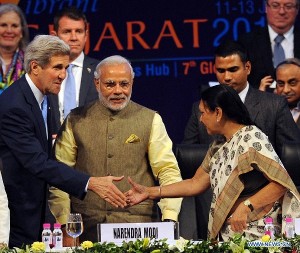

Follow us on:  
|

Two years ago, Mr. Narendra Modi led the Bharatiya Janata Party to a huge, even spectacular, victory in the Indian parliamentary elections, to form the first majority government in several decades, indeed since the late 1980s. This generated both hope and trepidation. Hope, because Mr. Modi in his election campaign presented himself as a moderniser who would eliminate corruption and cut through red tape to deliver growth and better material circumstances to hundreds of millions of farmers, small enterprises and young people desperately in search of decent employment.
And trepidation, because both he and his political party have a long and unfortunate history of stoking communal tension and creating discord along religious and ethnic lines, which could be deeply damaging to both society and polity.
The record so far seems to suggest that those who were pessimistic about what this government could do in terms of damage to society have been vindicated rather more than those who were optimistic about the impact on the economy.
It is true that the outside world tends to have a much rosier picture about the Indian economy. India has been described as “the only bright spot in a gloomy global economy” by people like Christine Lagarde of the IMF, and in general there is celebration of the fact that the Indian economy is now growing at what is apparently the fastest rate in the world, at around 7 per cent.
But within India people tend to be far more sceptical about both the current state of the economy and the potential for the immediate future. To begin with, the figures on income growth are under scrutiny because of how much the recent revision in GDP estimates by the statistical system has led to increased (possibly inflated) numbers.
The point is that this supposed increase in national income does not seem to be reflected in any other indicators that should also be going up.
Investment rates are still down – indeed they have been falling for several years now. Freight volumes and other indicators like electricity generation remain subdued. Agriculture – which still accounts for the basic livelihood of more than half the population – has been reeling under the impact of consecutive droughts and worsening conditions of production and sale of crops.
![A job crisis is brewing: Over 280 million people are estimated to enter the country’s job market by 2050 [Xinhua]](http://thebricspost.com/wp-content/uploads/2016/07/7l2833g11.jpg)
A job crisis is brewing: Over 280 million people are estimated to enter the country’s job market by 2050 [Xinhua]
Most significant of all, employment, which is one of the biggest concerns in the economy because of the fact that past growth was not associated with much job creation and almost zero formal employment growth, has not shown any acceleration.
So people in India are asking: Where is this income growth? What is driving it? Who is benefiting from it? What is the tangible evidence that it is happening at all?
These concerns are made more pressing because thus far most of the government’s economic policies seem to be more about optics and grand declarations than actually doing something meaningful. A slew of new initiatives has been announced, but none of them is likely to amount to much if the government does not put its money where its mouth is.
So the “Swacchh Bharat Abhiyaan” or “Clean India Campaign” was announced with much fanfare, but has been accompanied by a reduction in the funds allocated by the central government for sanitation and clean drinking water.
The “Smart Cities” programme has identified 100 cities that are supposed to become “smart”, but without any clear plans on what is actually to be done and more importantly without real resources to make significant changes.
The “Make in India” scheme is based on the hope that the government’s invitations to foreign investors to come and set up exporting industries within the country will be enough to attract them and galvanise more private investment – even though India’s own big industrialists are hardly investing anything themselves and continue to seek wider pastures outside the country for their own expansion.
The problems of large and growing bad debts held by the commercial banks continue to act as a drag on both sound finance and economic growth, but the government is not addressing this head on.

File photo: Indian Prime Minister Narendra Modi (centre) with US Secretary of State John Kerry [Xinhua]
Meanwhile, the BJP government has confirmed some of the worst fears about aggressive pushing of socio-religious divisions through things like bans on beef eating (and even murder of those believed to have beef in their homes or vehicles, regardless of whether their religion allows it or not); active suppression of dissent among those who fight for people rights through various forms of official and legal persecution; and attacks on students and universities on trumped up and ridiculous charges, even while scholarships that enable children from poorer homes to study are sought to be reduced.
It is strange that the outside world persists in seeing the Indian government and the economy uncritically exactly as the Modi government chooses to portray it, without bothering to look more closely into such obvious tendencies.
The Indian economy cannot be viewed as a bright spot globally until its growth is put on a more sustainable and equitable footing.
Jayati Ghosh is professor of economics at Jawaharlal Nehru university, New Delhi. She is one of the world’s leading economists. She is a regular columnist for Guardian, Frontline and the Hindu’s Businessline. She has been a consultant at ILO, UNDP, UNCTAD, UN-DESA, UNRISD and UN Women.